Traditional Wisconsin Booyah
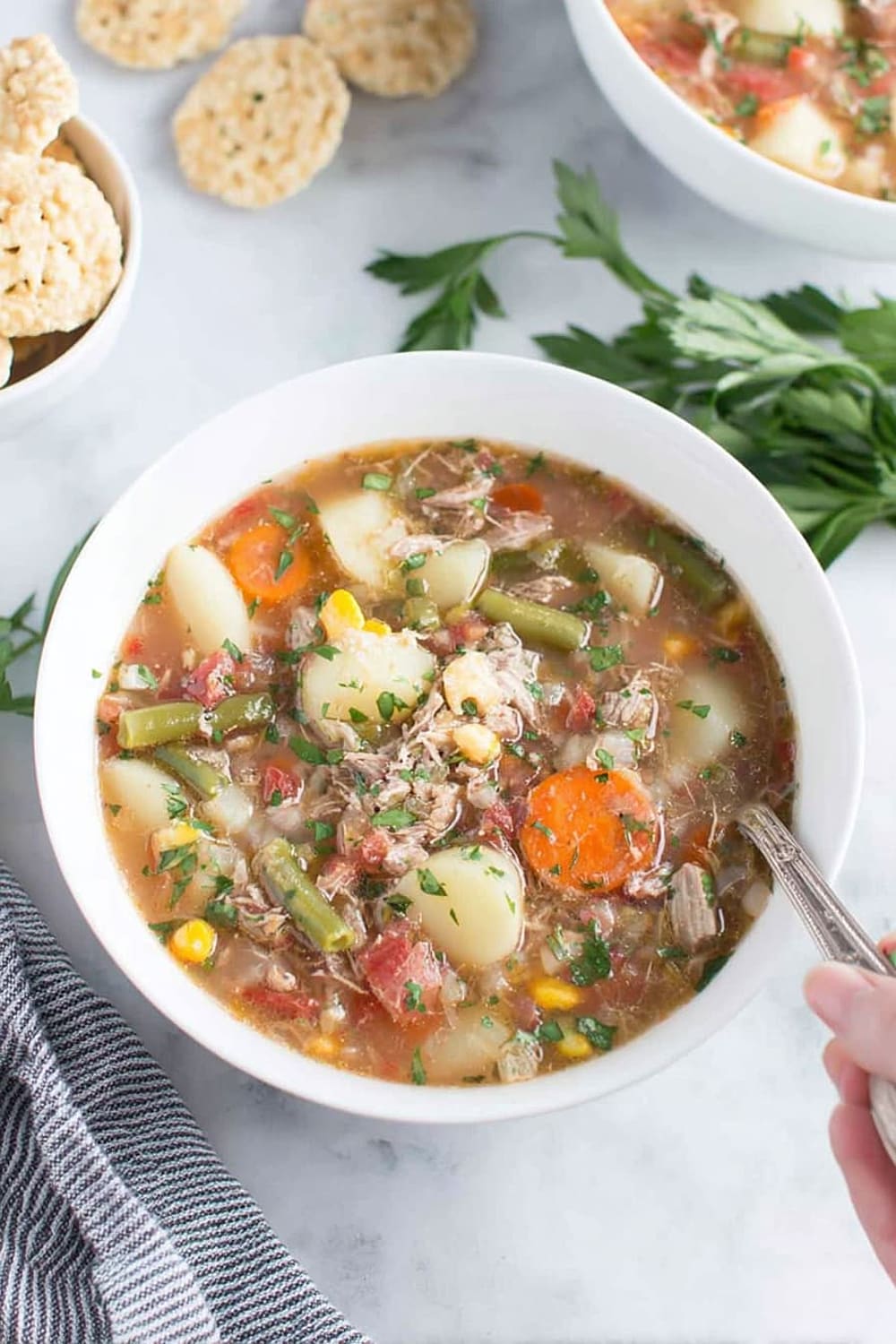
This hearty Wisconsin classic is about to become your new cold-weather obsession, and honestly, it’s the kind of soup that makes you feel like you’ve got your life together even when you’re wearing mismatched socks.
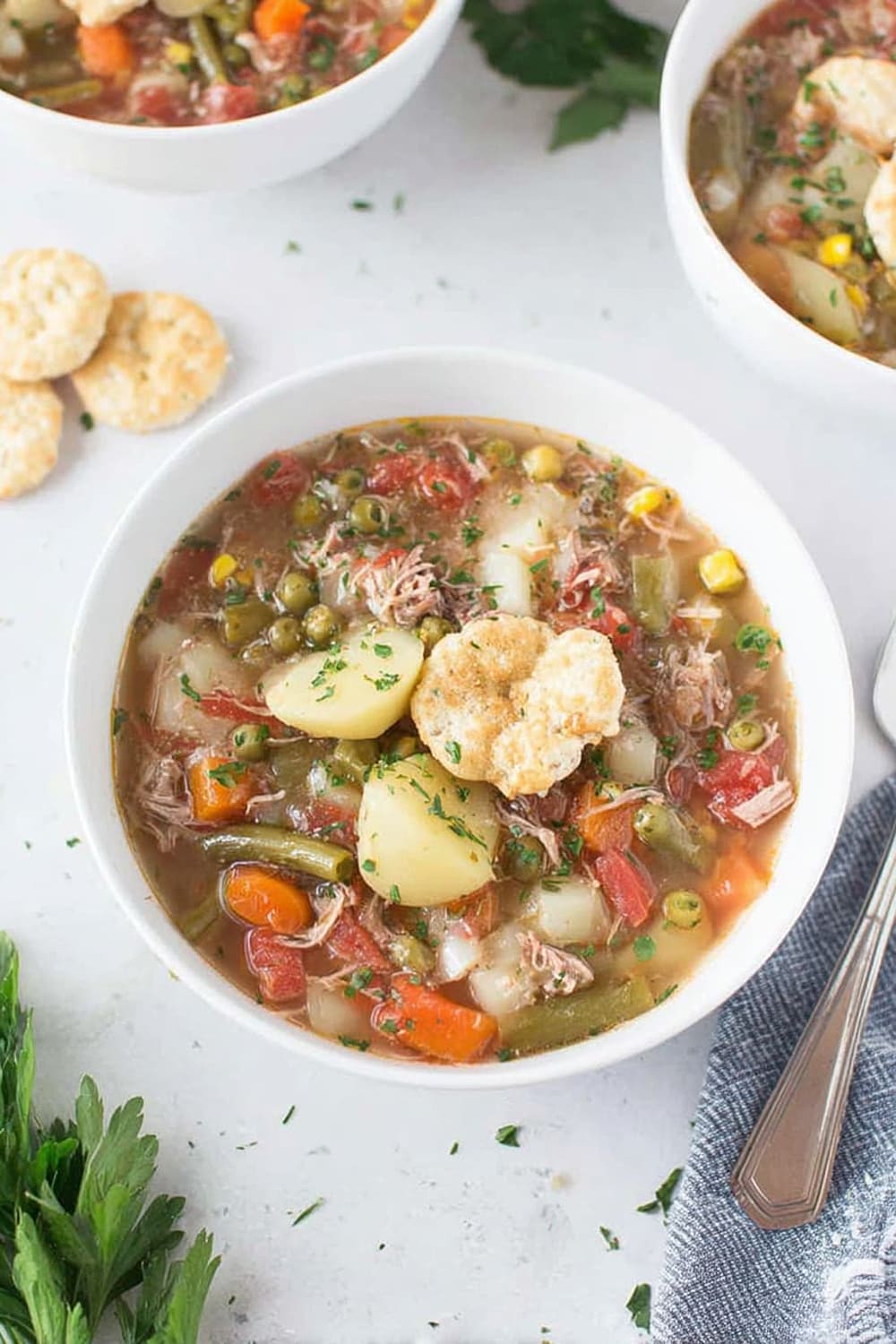
The name might sound ridiculous, but one spoonful of this rich, meaty masterpiece will have you understanding why Wisconsinites have been perfecting this recipe for generations.
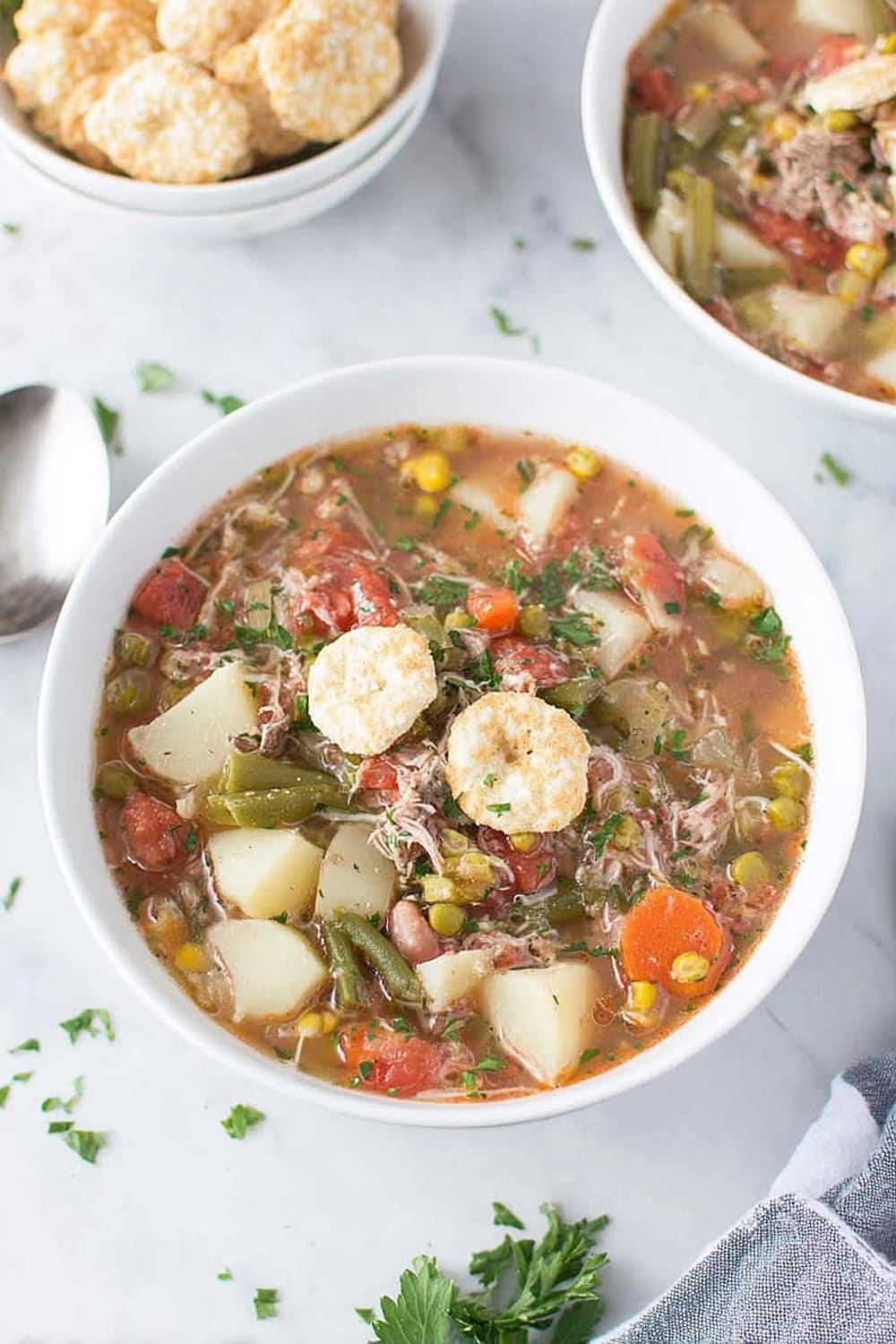
Picture tender chunks of chicken and beef swimming in a savory broth with perfectly cooked vegetables, creating the ultimate comfort food that’s basically a warm hug in a bowl.
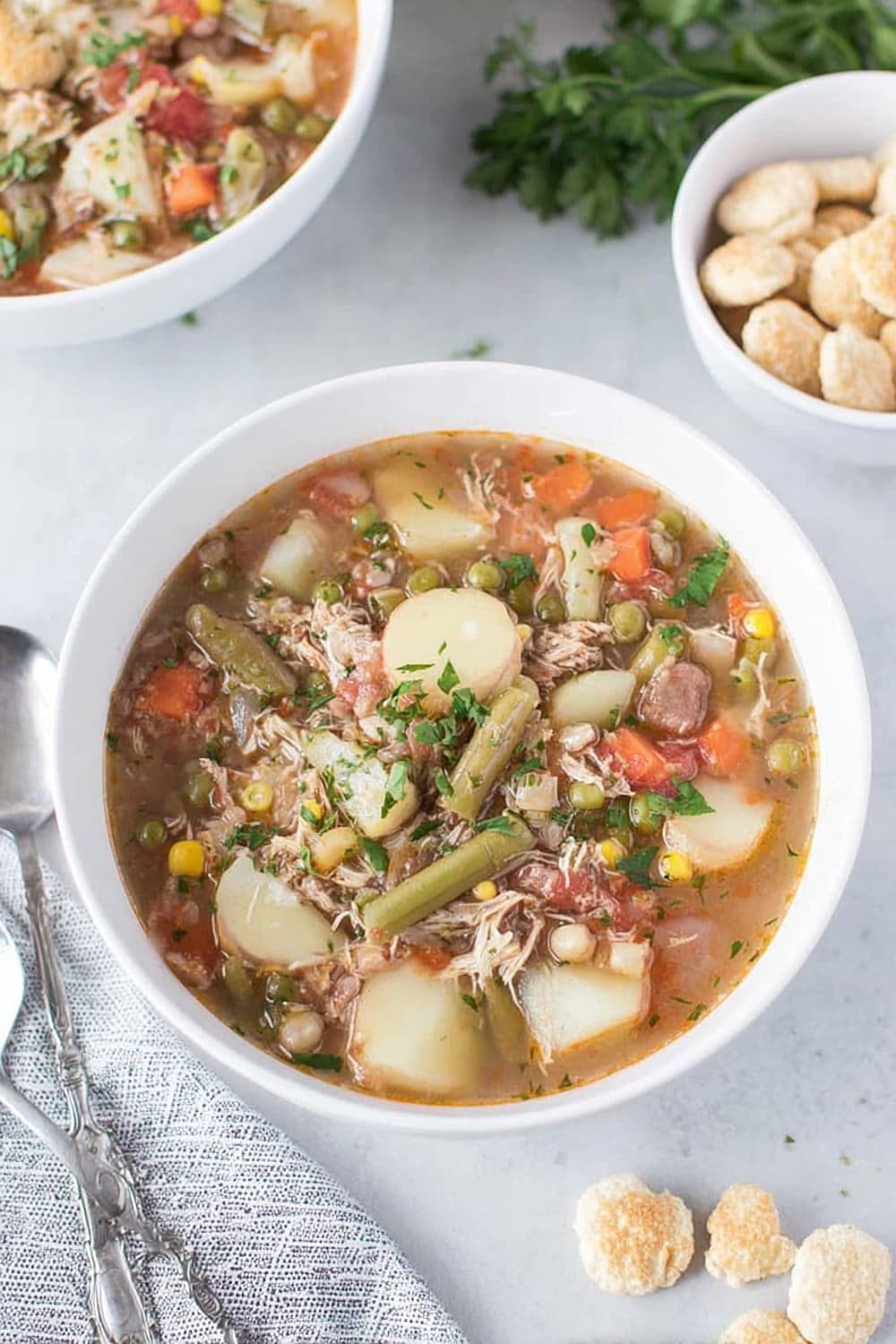
This scaled-down version serves a crowd without requiring you to cook for an actual Wisconsin church basement gathering, though it’s impressive enough that people will think you did.
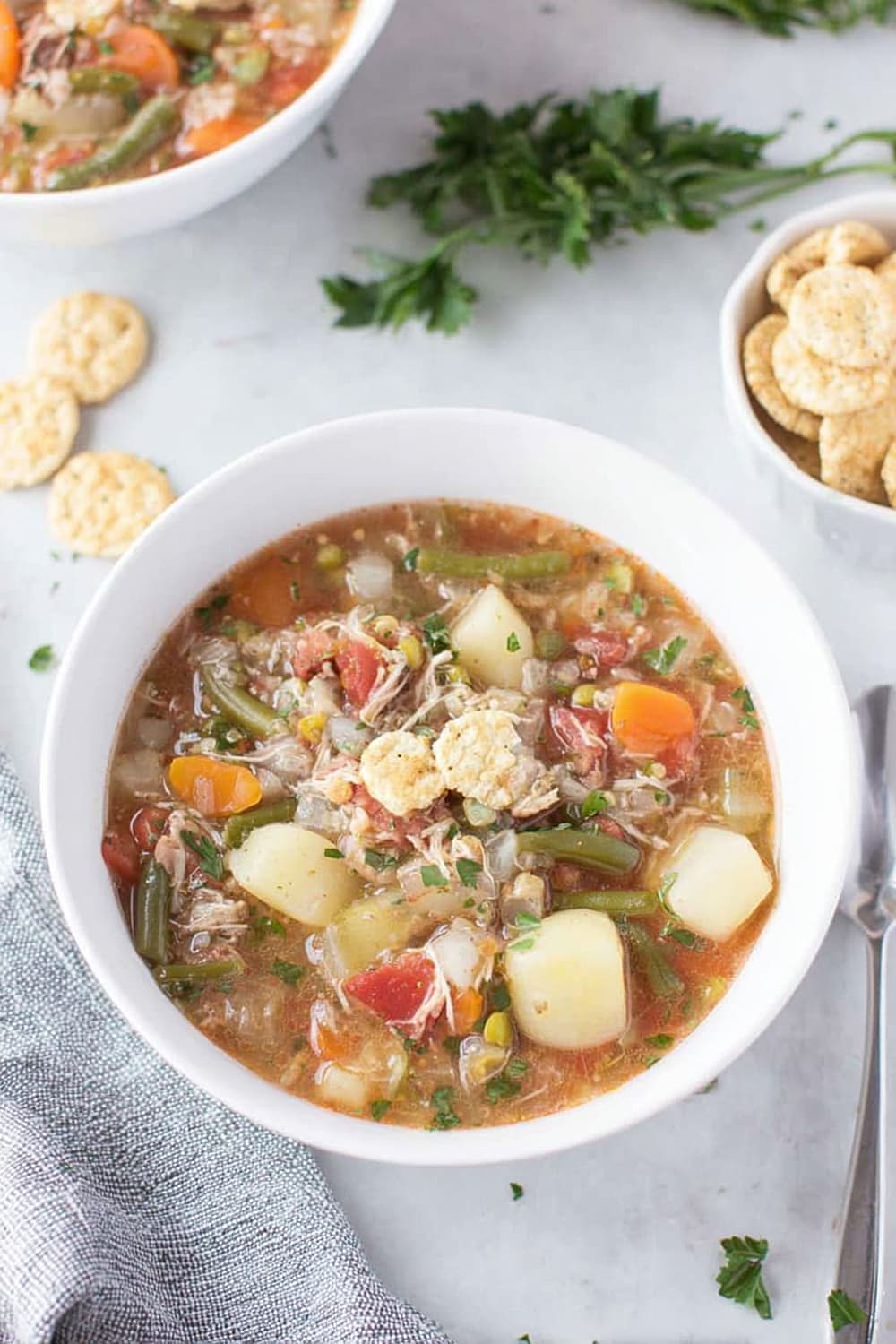
The slow simmering process transforms simple ingredients into something magical, filling your kitchen with aromas that will have neighbors mysteriously stopping by around dinnertime.
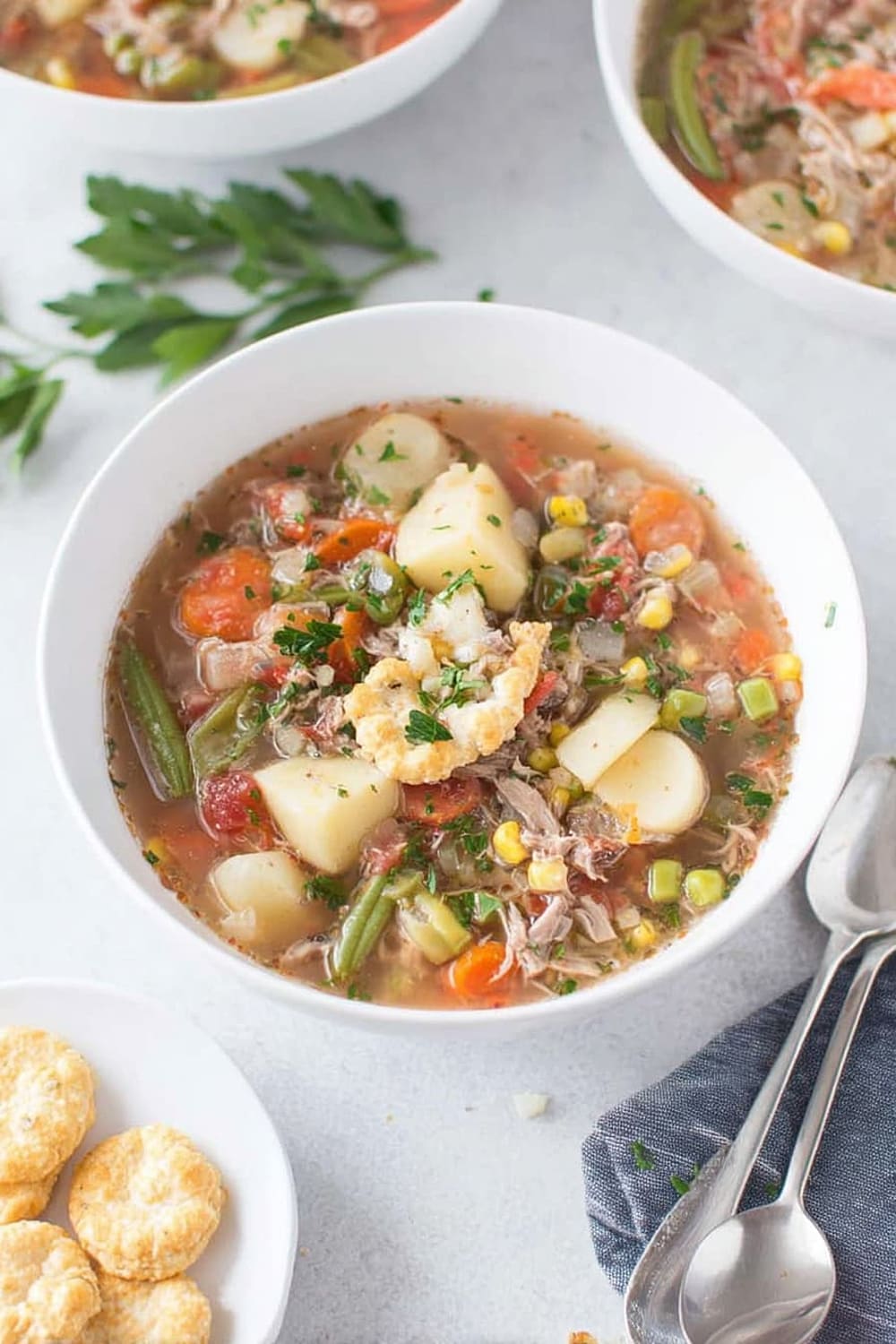
Fair warning: making this will result in requests for the recipe and possibly marriage proposals from anyone who tries it, so prepare accordingly.
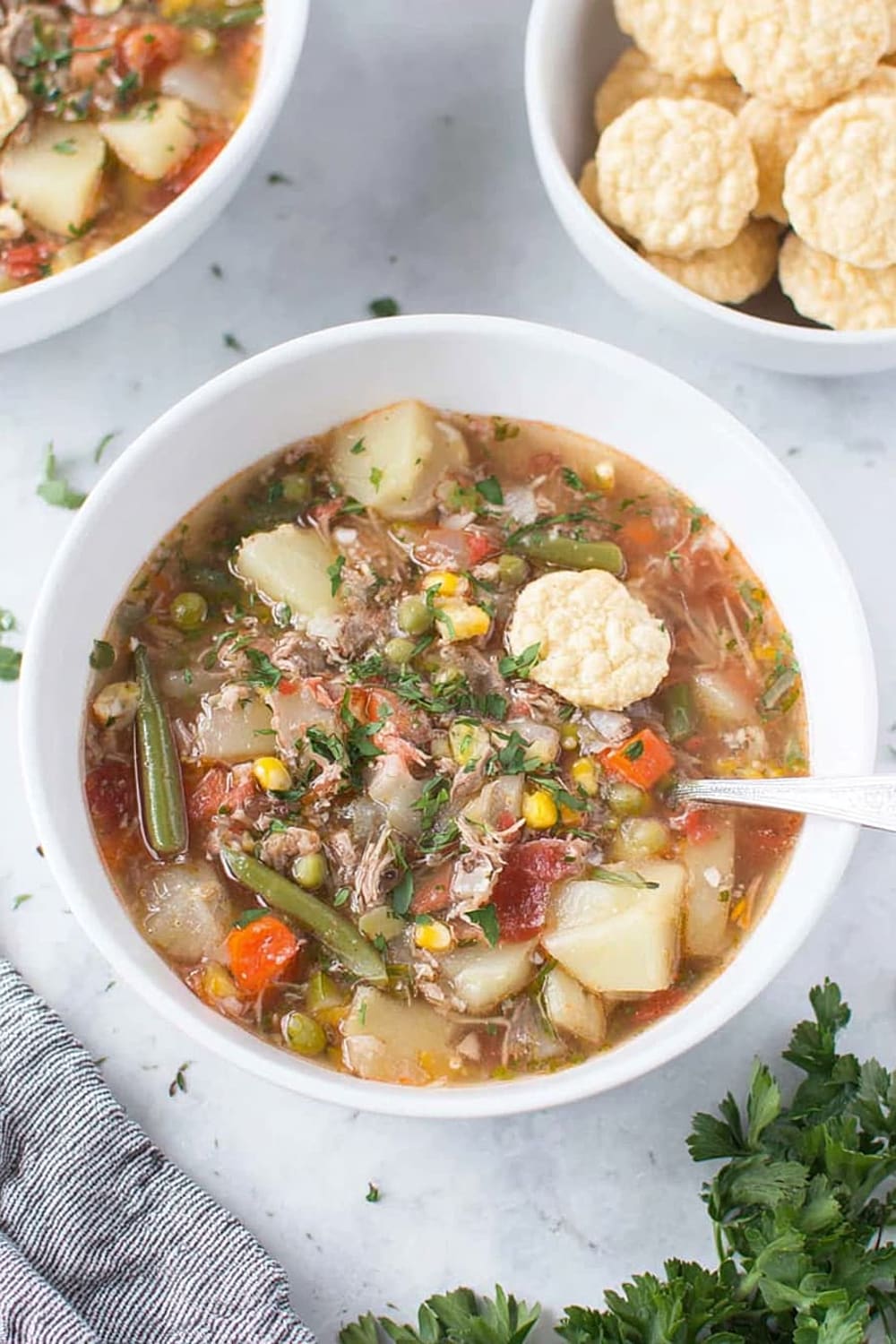
Ingredients
For the Protein Base
- 3 tablespoons olive oil
- 1 1/2 pounds chicken thighs (boneless, skinless)
- 1 pound beef stew meat
- 1 1/2 cups chopped onion
- 1 heaping tablespoon coarse salt
- 1 /2 teaspoon pepper
For the Broth
- 4 cups water (initial addition)
- 4 cups water (second addition)
- 2 bay leaves
- 1 tablespoon Worcestershire sauce
- 1 /2 tablespoon soy sauce
For the Vegetables
- 1 1/2 cups sliced celery
- 1 1/2 cups chopped carrots
- 1 1/2 cups shredded cabbage (or coleslaw mix)
- 2 – 2 1/2 pounds chopped potatoes
- 2 cans diced tomatoes
- 1 1/2 cups frozen cut green beans
- 1 cup frozen corn
- 1 cup frozen peas
For Serving
- Oyster crackers
Instructions
Building the Flavor Base
- 1 In a large Dutch oven or heavy-bottomed stockpot, heat 3 tablespoons olive oil over medium-high heat until it shimmers and moves freely around the pan. This creates the perfect foundation for browning your proteins without sticking.
- 2 Add the chicken thighs, beef stew meat, and chopped onion to the hot oil. Let the meat brown undisturbed for about 2-3 minutes before stirring, then continue cooking for another 2-3 minutes, stirring occasionally. You want to see golden-brown caramelization on the meat surfaces, which creates the deep, rich flavor that makes booyah special.
Creating the Broth
- 3 Season the browned meat mixture with 1 heaping tablespoon coarse salt and 1/2 teaspoon pepper, stirring to distribute evenly. Add 4 cups water and stir to combine, scraping up any browned bits from the bottom of the pot with a wooden spoon.
- 4 Bring the mixture to a rolling boil over high heat, then immediately cover the pot and reduce heat to low. The liquid should maintain a gentle simmer with just occasional bubbles breaking the surface. Simmer for 2 full hours, checking occasionally and adding more water if needed to maintain liquid levels.
- 5 After 2 hours, remove the lid and check the meat. It should be tender enough to shred easily with a fork. If needed, use two forks to break up any large pieces of chicken or beef into bite-sized chunks.
Adding the Vegetables
- 6 Add the sliced celery, chopped carrots, chopped potatoes, shredded cabbage, diced tomatoes (with their juice), frozen green beans, frozen corn, frozen peas, bay leaves, the remaining 4 cups water, Worcestershire sauce, and soy sauce to the pot. Stir gently to combine all ingredients.
- 7 Cover the pot again and continue simmering for an additional 2 hours. The vegetables should be fork-tender but not mushy, and the broth should have a rich, golden color with layers of flavor from the long cooking process.
- 8 Remove and discard the bay leaves before serving. Taste and adjust seasoning with additional salt and pepper if needed. Serve hot in large bowls with oyster crackers on the side for the authentic Wisconsin experience.
Recommended Equipment and Kitchen Tools
Essential Tools (for best results)
- Large Dutch oven or heavy stockpot – A 6-8 quart capacity is ideal for this recipe, and the heavy bottom prevents scorching during the long simmering process
- Wooden spoon – Perfect for stirring without scratching your pot and for scraping up those flavorful browned bits
- Sharp chef’s knife – Makes quick work of all the vegetable prep, and a quality blade ensures uniform cuts for even cooking
- Large cutting board – You’ll need plenty of space for prepping multiple vegetables
Helpful Upgrades
- Immersion blender – If you prefer a slightly thicker consistency, you can blend a portion of the soup directly in the pot
- Kitchen scale – For the most accurate measurements, especially when portioning the meat
- Ladle with pour spout – Makes serving much cleaner and helps control portion sizes
- Fine-mesh strainer – Useful if you want to remove any small bits before serving
Nice-to-Have Options
- Slow cooker insert – Some Dutch ovens come with slow cooker functionality, perfect for this long-simmering recipe
- Storage containers – This recipe makes a large batch, so having quality containers for leftovers is essential
- Instant-read thermometer – Ensures your meat reaches safe internal temperatures during the browning process
Recipe Variations and Dietary Modifications
Protein Variations
- Turkey and pork – Substitute turkey thighs and pork shoulder for a different flavor profile while maintaining the dual-meat tradition
- All-chicken version – Use 2 1/2 pounds mixed chicken pieces (thighs, drumsticks, and breast) for a lighter option
- Wild game adaptation – Replace beef with venison or elk for an authentic Wisconsin hunting season version
- Seafood twist – Add 1 pound white fish fillets in the last 30 minutes for a Great Lakes variation
Vegetable Modifications
- Root vegetable medley – Add parsnips, turnips, or rutabaga along with the carrots for earthier flavors
- Seasonal additions – Include fresh corn kernels and tomatoes in summer, or winter squash in fall
- Mushroom enhancement – Add 8 ounces sliced mushrooms with the onions for deeper umami flavors
- Spicy version – Include diced jalapeños or a dash of hot sauce for heat
Dietary Adaptations
- Lower sodium – Use low-sodium broth instead of water and reduce salt to 1 teaspoon
- Paleo-friendly – Omit corn and use sweet potatoes instead of regular potatoes
- Vegetarian version – Replace meats with 2 pounds mixed mushrooms and use vegetable broth
Nutritional Information and Health Benefits
Key Nutritional Highlights
This hearty booyah provides approximately 285 calories per serving when divided into 32 portions, making it a satisfying yet reasonable meal option. The dual protein sources deliver about 22 grams of high-quality protein per serving, supporting muscle maintenance and satiety. With over 6 grams of fiber from the abundant vegetables, this soup supports digestive health while providing sustained energy.
Health Benefits of Main Ingredients
The chicken thighs provide lean protein along with selenium and phosphorus for immune function and bone health. Beef stew meat contributes iron, zinc, and B-vitamins, particularly B12, which supports energy metabolism and nervous system function. The colorful vegetable medley delivers a spectrum of antioxidants – carrots provide beta-carotene for eye health, while tomatoes offer lycopene for heart health. The cabbage family vegetables contain sulfur compounds that support detoxification processes.
Dietary Considerations
This recipe is naturally gluten-free (when served without crackers), dairy-free, and nut-free, making it suitable for many dietary restrictions. The long cooking process breaks down tough fibers, making nutrients more bioavailable. Each serving provides approximately 18 grams of carbohydrates, primarily from vegetables and potatoes, with minimal added sugars. The sodium content can be controlled by adjusting salt levels and choosing low-sodium canned tomatoes.
Smart Swaps and Ingredient Substitutions
Common Substitutions:
- Chicken thighs → Chicken breast or drumsticks (adjust cooking time as breast meat cooks faster)
- Beef stew meat → Chuck roast cut into chunks or short ribs for richer flavor
- Fresh vegetables → Frozen vegetable medley (add 1 cup less liquid to account for ice crystals)
- Coleslaw mix → Fresh shredded cabbage or Brussels sprouts, thinly sliced
Budget-Friendly Swaps:
- Beef stew meat → Ground beef (brown first, then drain excess fat)
- Individual frozen vegetables → Mixed frozen vegetable blend (often more economical)
- Fresh celery and carrots → Frozen mirepoix blend for convenience
- Canned diced tomatoes → Fresh tomatoes, chopped when in season
Pantry Emergency Substitutions:
- Worcestershire sauce → Soy sauce plus a dash of vinegar for similar umami depth
- Bay leaves → 1 teaspoon dried thyme or oregano for herbal notes
- Fresh onion → 2 tablespoons onion powder (add with other seasonings)
- Olive oil → Vegetable oil or butter for browning
Pro Tips for Substitutions:
- Root vegetables hold their shape better than softer vegetables during long cooking
- Frozen vegetables should be added in the final hour to prevent overcooking
- Ground meats reduce cooking time to 3 hours total instead of 4
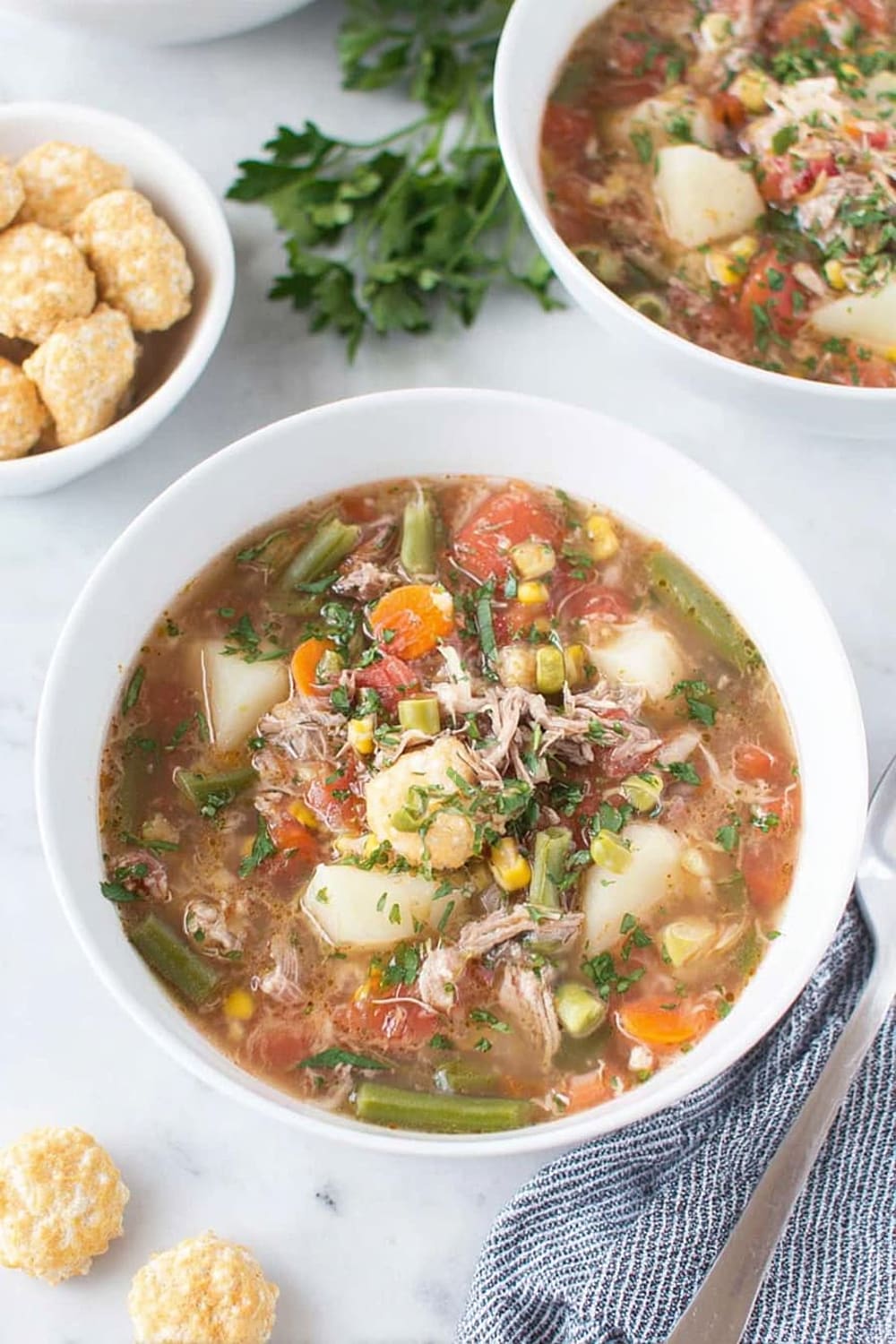
Make It Diabetes-Friendly
Carbohydrate Modifications:
- Reduce potatoes to 1 pound and add 1 pound cauliflower florets to cut carbs by approximately 15 grams per serving
- Substitute half the potatoes with turnips or radishes for similar texture with fewer carbs
- Add extra protein by increasing meat portions to 2 pounds chicken and 1.5 pounds beef for better blood sugar stability
Portion & Timing Tips:
- Serve smaller portions (1 cup instead of 1.5 cups) alongside a large green salad to increase fiber and reduce carb load
- Estimated carbs per serving: Approximately 12-15 grams with potato reduction modifications
- Pair with healthy fats like avocado slices or a drizzle of olive oil to slow glucose absorption
- Best timing: Serve as lunch when metabolism is typically higher, or as dinner with a 30-minute post-meal walk
Blood Sugar Friendly Additions:
- Add extra fiber with 1 cup chopped kale or spinach in the final 10 minutes
- Include cinnamon (1/2 teaspoon) which may help with glucose metabolism
- Serve with protein-rich sides like hard-boiled eggs or cheese for sustained energy
Total Carb Reduction: Modified version contains approximately 40% fewer carbohydrates than the original recipe while maintaining the authentic Wisconsin flavor profile.
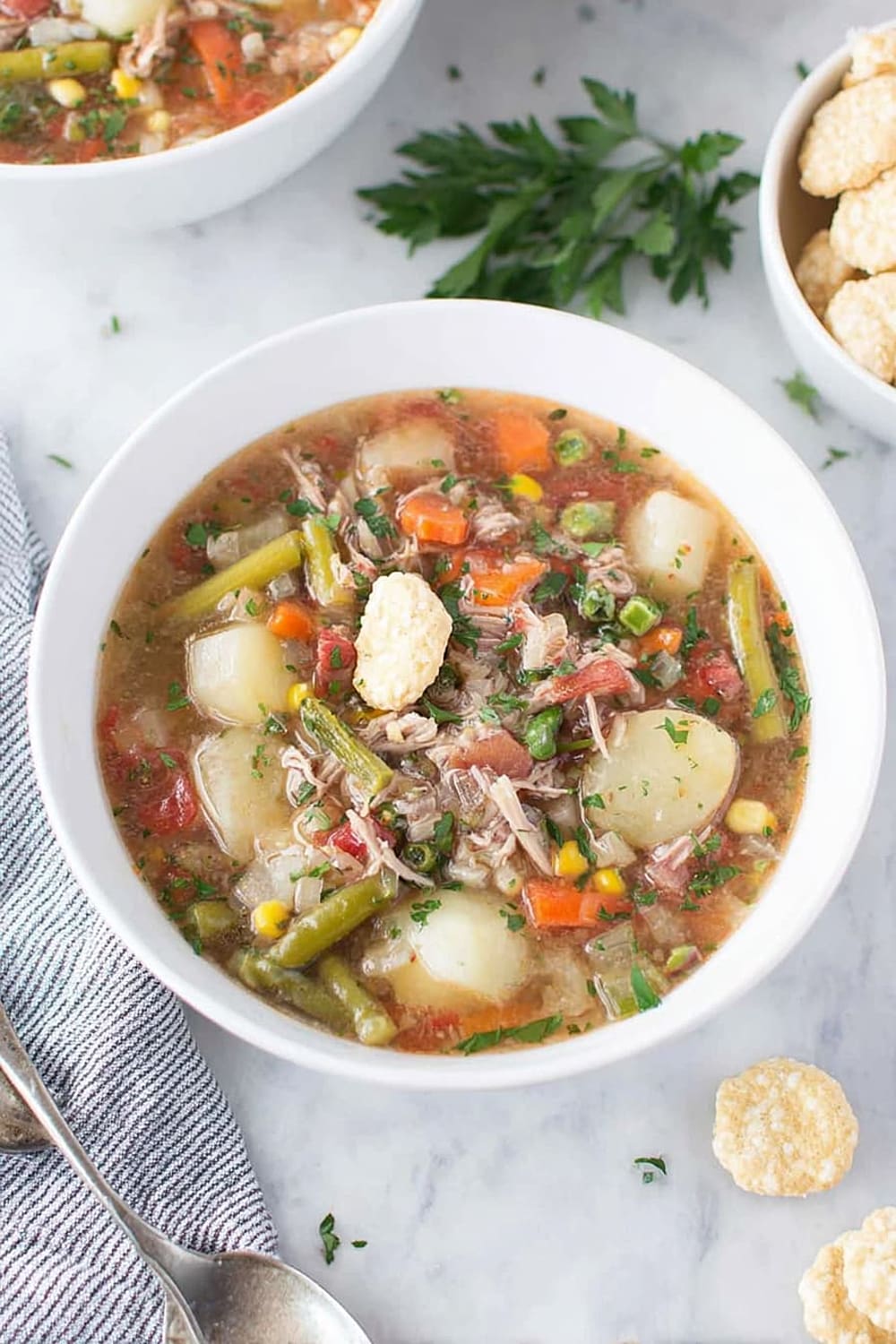
Perfect Pairing Suggestions
Beverage Pairings
A robust Wisconsin craft beer like a brown ale or porter complements the hearty meat flavors beautifully, while the malty sweetness balances the savory vegetables. For wine lovers, a medium-bodied Pinot Noir or Côtes du Rhône provides enough structure to stand up to the rich broth without overwhelming the delicate vegetable flavors. Non-alcoholic options include sparkling apple cider for fall gatherings or iced tea with lemon for a refreshing contrast to the warming soup.
Side Dish Recommendations
Crusty sourdough bread or cornbread provides the perfect vehicle for sopping up every drop of that flavorful broth. A crisp coleslaw with apple cider vinegar dressing adds textural contrast and cuts through the richness. Roasted root vegetables seasoned with herbs complement the soup’s earthy flavors, while pickled beets or dill pickles offer the traditional Wisconsin tangy element that locals expect.
Complete Meal Ideas
Start with Wisconsin cheese curds or a simple green salad with buttermilk dressing to honor the regional theme. Follow the booyah with apple crisp or pumpkin bars for dessert, especially during fall and winter months. For entertaining, set up a toppings bar with shredded cheese, sour cream, chopped green onions, and hot sauce so guests can customize their bowls.
Occasion Suggestions
This recipe shines at tailgate parties, church potlucks, and family reunions where feeding a crowd is essential. It’s perfect for Sunday dinners when you want something special but manageable, and ideal for meal prep since it freezes beautifully and tastes even better the next day.
Pro Tips and Troubleshooting
Professional Techniques
Brown the meat in batches if your pot seems crowded – overcrowding creates steam instead of the caramelization that builds flavor. Skim foam from the surface during the first 30 minutes of simmering for a clearer, more refined broth. Taste and adjust seasoning after each major addition, as the long cooking time can mellow flavors that seemed perfect initially.
Common Mistakes and Solutions
If your soup turns out too thin, remove 2 cups of liquid and simmer it separately until reduced by half, then stir it back in for concentrated flavor. Mushy vegetables indicate they were added too early – frozen vegetables should only be added in the final 2 hours. Lack of flavor depth usually means insufficient browning at the beginning or not enough seasoning adjustments throughout cooking.
Storage and Make-Ahead Strategy
This soup improves overnight as flavors meld, making it perfect for entertaining. Store in the refrigerator for up to 5 days or freeze in portions for up to 6 months. When reheating, add a splash of water or broth as the vegetables will absorb liquid over time. Freeze in meal-sized portions using freezer bags laid flat for efficient storage and faster thawing.
Scaling and Presentation
To double the recipe, use a 12-quart stockpot and increase cooking times by 30 minutes per phase. For elegant presentation, serve in warmed bowls with a sprinkle of fresh parsley and oyster crackers arranged on the side rather than floating in the soup.
This traditional Wisconsin booyah represents everything wonderful about Midwest comfort food – it’s hearty, practical, and brings people together around the table. The long, slow cooking process might seem intimidating, but it’s actually quite forgiving and mostly hands-off, giving you time to tackle other tasks while your kitchen fills with incredible aromas. Whether you’re feeding a crowd or meal-prepping for the week, this scaled-down version delivers all the authentic flavors that have made booyah a beloved Wisconsin tradition for generations.